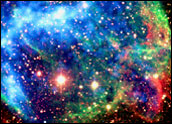
Star gazers and astronomers now have a powerful new tool that will allow them to surf the skies from their desktop. Microsoft unveiled the public beta of its WorldWide Telescope (WWT) Web application Monday.
The software creates an experience that users of all ages will find captivating, said Frank Reddy, a senior editor at Astronomy Magazine.
“There are other tools that can teach you the constellations, but WorldWide Telescope is an immersive environment that basically throws you into space and allows you to navigate very easily and smoothly. It can be both a teaching platform, a research platform and even an entertainment platform,” he told TechNewsWorld.
Virtual Star Gazer
To create WWT, Microsoft drew from its knowledge of software and Web 2.0 services powered by its Visual Experience Engine to create the visualization software that transforms PCs into virtual telescopes. WWT combines both ground- and space-based images gathered from observatories.
The application “stitches together” terabytes of high-resolution images of celestial bodies to display them in roughly the same spot in which they reside in the sky. This allows users to seamlessly pan around the galaxies, zooming in and out with the mouse. The application portal also mixes in copious amounts of information and stories to give a complete picture of each known entity in space and complement the images.
“It’s more than just a program that shows you the stars — there are lots of those — what it does that’s really interesting is essentially put the universe in a game interface. Microsoft Visual Experience Engine, if I understand it, is part of what they use in games. So they’ve given the look and feel of a good computer game to the interface,” Reddy explained.
“In fact, [Microsoft] hopes that there will be versions of this for the Xbox. They want to target younger people who are playing games more than thinking of science,” he added.
Fly Me to the Moon
Users can comb the outer reaches of space or stay close to home exploring our solar system. They can browse freely or click on one of several guided tours narrated by astronomers and educators.
Users can also choose which telescope they will look through; choices include the Hubble Space Telescope and the Chandra X-Ray Observatory Center, among others. They can then opt, for instance, to view locations of planets in the night sky from the past, present or future.
WWT users can also look at the universe using a variety of different wavelengths, including infrared and x-ray.
“[The tours] are easy to customize,” said Lynn Cominsky, professor and chair of the Department of Physics and Astronomy at Sonoma State University, told TechNewsWorld. “Also, the little thumbnails that appear across the bottom of the screen show you really interesting things to explore in every field that you are viewing in the panoramic mode,” she noted.
“This is an exceptionally versatile and amazing product, which has a great ‘awe’ factor — it will be very popular with the public,” she said. “Both professional and amateur astronomers will be thrilled with this tool, it will be great at star parties and for doing classroom and public presentations.”
In an homage to Jim Gray, a Microsoft researcher who disappeared while boating off the coast of California last year, Microsoft has made WWT available at no charge.
Star Wars
Although Google launched its Web-based Google Sky service back in March, Microsoft has been working on the WWT project for several years.
Google Sky, a spinoff from Google Earth, offers many of the same viewing choices but is a less rich experience, according to Reddy.
“[Google Sky] is not in any way, shape or form as fluid and immediate as WorldWide Telescope,” he said. “Google Sky is a good product, and it is trying to do similar kinds of things, but they are different enough that I think there’s room for both of them,” he said.
The impact of such tools on educators and science education cannot be underestimated now that the two industry heavyweights have drawn attention to the field.
“WWT already contains real data on the planets, the Earth and the sky in many different wavelengths of light, and from the three orbiting Great Observatories — Hubble, Chandra and Spitzer. It can be used in a variety of different ways in the classroom. It provides different perspectives on a multitude of astronomical phenomena as well as being easy to navigate,” said Cominsky
“You can see that both Google and Microsoft have discovered that astronomy is an interesting thing. Astronomers are accessible and they want their work talked about. They want people to see the images and be inspired by them,” said Reddy.
Microsoft already has plans to enhance WWT, according to Reddy, though he could not pinpoint which version the improvements would appear in.
“Tools for creators are coming. Right now there is no real way to do some things like put images on the sky,” he said.
“They would like to have interactive [tours] so as you click on a nebula that would branch out to a different part of the slide tour. You can create a very complex slide tour that was interactive and depended on the answers that people gave or click on,” Reddy added.
System Requirements
System requirements for WWT are fairly hefty. PCs must have an Intel Core 2 Duo processor running 2 gigahertz or faster. A minimum of one gigabyte of RAM is required, although 2 GBs of RAM is recommended.
A 3-D accelerated graphics card with 128 MB of RAM is a must. For better performance, Microsoft recommends a discrete graphics card with dedicated 256 MB VRAM.
Users must also have at least 1 GB of space on their hard drives; as much as 10 GB is recommended for offline features and high-performance browsing.
Macs must be running a version of Windows and meet roughly the same technical specifications.




















































